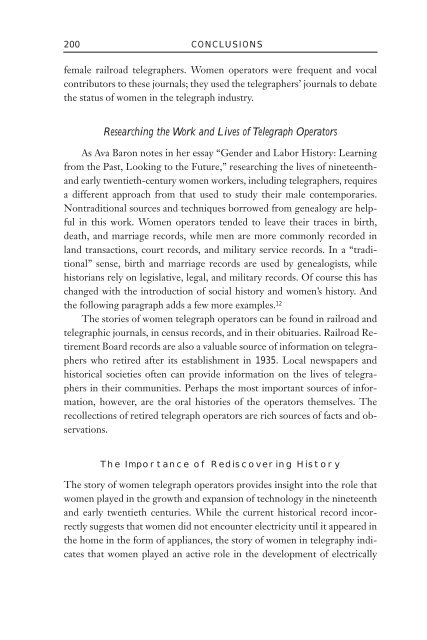My Sisters Telegraphic: Women in the Telegraph Office ... - Monoskop
My Sisters Telegraphic: Women in the Telegraph Office ... - Monoskop
My Sisters Telegraphic: Women in the Telegraph Office ... - Monoskop
You also want an ePaper? Increase the reach of your titles
YUMPU automatically turns print PDFs into web optimized ePapers that Google loves.
200<br />
CONCLUSIONS<br />
female railroad telegraphers. <strong>Women</strong> operators were frequent and vocal<br />
contributors to <strong>the</strong>se journals; <strong>the</strong>y used <strong>the</strong> telegraphers’ journals to debate<br />
<strong>the</strong> status of women <strong>in</strong> <strong>the</strong> telegraph <strong>in</strong>dustry.<br />
Research<strong>in</strong>g <strong>the</strong> Work and Lives of <strong>Telegraph</strong> Operators<br />
As Ava Baron notes <strong>in</strong> her essay “Gender and Labor History: Learn<strong>in</strong>g<br />
from <strong>the</strong> Past, Look<strong>in</strong>g to <strong>the</strong> Future,” research<strong>in</strong>g <strong>the</strong> lives of n<strong>in</strong>eteenthand<br />
early twentieth-century women workers, <strong>in</strong>clud<strong>in</strong>g telegraphers, requires<br />
a different approach from that used to study <strong>the</strong>ir male contemporaries.<br />
Nontraditional sources and techniques borrowed from genealogy are helpful<br />
<strong>in</strong> this work. <strong>Women</strong> operators tended to leave <strong>the</strong>ir traces <strong>in</strong> birth,<br />
death, and marriage records, while men are more commonly recorded <strong>in</strong><br />
land transactions, court records, and military service records. In a “traditional”<br />
sense, birth and marriage records are used by genealogists, while<br />
historians rely on legislative, legal, and military records. Of course this has<br />
changed with <strong>the</strong> <strong>in</strong>troduction of social history and women’s history. And<br />
<strong>the</strong> follow<strong>in</strong>g paragraph adds a few more examples. 12<br />
The stories of women telegraph operators can be found <strong>in</strong> railroad and<br />
telegraphic journals, <strong>in</strong> census records, and <strong>in</strong> <strong>the</strong>ir obituaries. Railroad Retirement<br />
Board records are also a valuable source of <strong>in</strong>formation on telegraphers<br />
who retired after its establishment <strong>in</strong> 1935. Local newspapers and<br />
historical societies often can provide <strong>in</strong>formation on <strong>the</strong> lives of telegraphers<br />
<strong>in</strong> <strong>the</strong>ir communities. Perhaps <strong>the</strong> most important sources of <strong>in</strong>formation,<br />
however, are <strong>the</strong> oral histories of <strong>the</strong> operators <strong>the</strong>mselves. The<br />
recollections of retired telegraph operators are rich sources of facts and observations.<br />
The Importance of Rediscover<strong>in</strong>g History<br />
The story of women telegraph operators provides <strong>in</strong>sight <strong>in</strong>to <strong>the</strong> role that<br />
women played <strong>in</strong> <strong>the</strong> growth and expansion of technology <strong>in</strong> <strong>the</strong> n<strong>in</strong>eteenth<br />
and early twentieth centuries. While <strong>the</strong> current historical record <strong>in</strong>correctly<br />
suggests that women did not encounter electricity until it appeared <strong>in</strong><br />
<strong>the</strong> home <strong>in</strong> <strong>the</strong> form of appliances, <strong>the</strong> story of women <strong>in</strong> telegraphy <strong>in</strong>dicates<br />
that women played an active role <strong>in</strong> <strong>the</strong> development of electrically

















